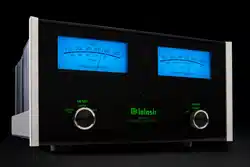Loading ...
Loading ...
Loading ...

9
Gauge). The smaller the Gauge number, the larger the
wire size:
Loudspeaker Cable Distance vs Wire Gauge Guide
Loudspeaker
Impedance
25 feet
(7.62 meters)
or less
50 feet
(15.24 meters)
or less
100 feet
(30.48 meters)
or less
2 Ohms
12AWG 10AWG 8AWG
4 Ohms
14AWG 12AWG 10AWG
8 Ohms
16AWG 14AWG 12AWG
5. Prepare the Loudspeaker Hookup Cables for attach-
ment to the MC312 Power Amplifiers:
Bare wire cable ends:
Carefully remove sufficient insulation from the
cable ends, refer to figures 2, 3 & 4. If the cable
is stranded, carefully twist the strands together
as tightly as possible.
Notes: 1. If desired, the twisted ends can be tinned
with solder to keep the strands together.
2. The prepared bare wire cable ends may be
inserted into spade lug connectors for use
in outside the United States and Canada
only.
3. Banana plugs are for use in the United
States and Canada only.
Banana Plugs are for use in the United States and
Canada only:
6. Attach the previously prepared bare
wire cable ends into the banana plugs
and secure the connections. Refer to
f ig u r e F.
1. For Remote Power Control, connect a power control
cable from the Audio Preamplifier or A/V Con-
trol Center Power Control Output 1 to the MC312
POWER CONTROL IN Amplifier One.
Note: When a Power Control Cable is connected
between the MC312 and Preamplifier (or A/V
Control Center), the AUTO OFF Feature is
bypassed. Refer to page 13.
2. Connect a power control cable from Amplifier One
Power Control OUTput 1 to the MC312 POWER
CONTROL IN Amplifier Two.
Note: When the MC312 (Power Amplifier 2) has
Loudspeakers connected to it with a Power
Control Input, then connect the MC312
Power Control Out 1 and Out 2 to the
Loudspeakers.
3. Connect XLR cables from the Balanced Output 1
(L&R) of an Audio Preamplifier or A/V Control
Center to the MC312 Balanced INput (RIGHT and
LEFT) on Amplifier One. Place the INPUT MODE
Switch in the BALANCED Position.
Note: An optional hookup is to use unbalanced
cables and place the INPUT MODE Switch in
the UNBALANCED Position.
4. Connect XLR cables from the MC312 (Power
Amplifier 1)Audio Balanced OUTput (LEFT and
RIGHT) to the MC312 (Power Amplifier 2) Bal-
anced INput (RIGHT and LEFT). Place the INPUT
MODE Switch in the BALANCED Position.
This McIntosh MC312 Power Amplifier is designed
for Loudspeakers with an impedance of 2 ohms, 4
ohms or 8 ohms. Connect a single Loudspeaker only
to the Right and Left Output Terminals.
When connecting Loudspeakers to the MC312 it
is very important to use cables of adequate size, so
there is little to no power loss in the cables. The size is
specified in Gauge Numbers or AWG (American Wire
Caution: Do not connect the AC Power Cord to the
MC312 Rear Panel until after the Loudspeaker
Connections are made. Failure to observe this
could result in Electric Shock.
The connection instructions below, together with the
MC312 Connection Diagram located on the separate
folded sheet “Mc1B”, is an example of a typical audio
system. Your system may vary from this, however the
actual components would be connected in a similar
manner. For additional information refer to “Connec-
tor and Cable Information” on page 3.
Figure 2
Figure 3 Figure 4
How to Connect for Bi-Amp
When connecting the Loudspeaker Hookup Cables to
the MC312 Power Amplifier Output Terminals please
follow the steps below:
1. Rotate the top of the Output Terminal Post coun-
terclockwise until an opening
appears. Refer to gures A and
B.
2. Insert the Loudspeaker hookup
cable into the Output Terminal
Post opening or the cable spade
lug around the center post of
the Output Terminal. Refer to
gure C.
3. Rotate the top of the Output
Terminal Post clockwise until it
is nger tight. Refer to gure D.
4. Place the supplied McIntosh
Wrench over the top of the Out-
put Terminal and rotate it one
quarter of a turn (90° ) to secure
the Loudspeaker Cable Connec-
tion. Do not over tighten. Refer
to gure E.
Output Terminals
Figure A
Opening
Figure B
Figure C Figure D
Figure E
Figure F
Figure H
Output Terminals and How to Connect for Bi-Amp
Loading ...
Loading ...
Loading ...
